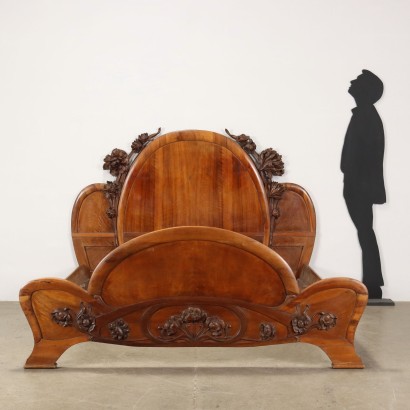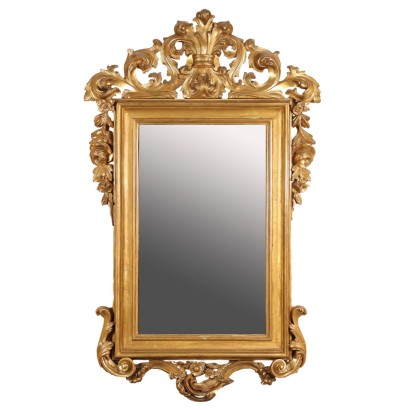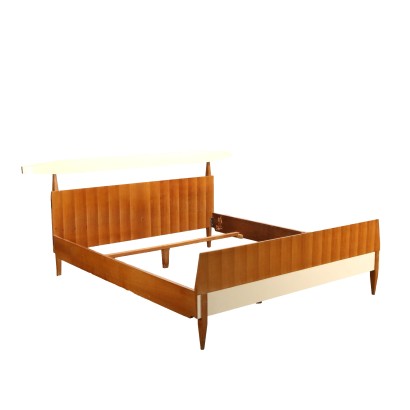Ancient Bed Art Nouveau Attr. to C. Zen Walnut Italy XX Century - Milan, Early XX Century
Features
Milan, Early XX Century
Style: Art Nouveau (1890-1920)
Age: 19th Century / 1801 - 1900 , 20th Century / 1901 - 2000
Origin: Milano, Lombardia, Italy
Main essence: Walnut
Material: Carved Wood
Description
Art Nouveau bed in walnut attributable to Carlo Zen, forming part of a bedroom composed of wardrobe, chest of drawers, pettineuse, bed, pair of bedside tables, armchair and two chairs. Trilobate headboard and footboard, the first characterized by voluminous finely sculpted flower applications, the second decorated with floral carvings of the same taste placed on the front.
Product Condition:
Product which due to age and wear requires restoration and re-polishing. We try to present the real state of the furniture as fully as possible with photos. If some details are not clear from the photos, what is reported in the description will prevail.
Dimensions (cm):
Height: 30
Width: 164
Depth: 200
Bed frame maximum sizes (cm):
Height: 135,5
Width: 190
Depth: 211
Additional Information
Notes historical bibliographic
Bed forming part of a liberty bedroom in walnut consisting of wardrobe, chest of drawers, pettineuse, bed, pair of bedside tables, armchair and two chairs. The furnishings are characterized by the high structural and carving quality, the latter clearly visible above all in the voluminous, finely sculpted floral applications. Built in the early years of the 20th century, the room seems to all intents and purposes to be the product of the collaboration of two great cabinet makers such as Achille Falceri, owner of the historic furniture factory based in via 4 Spade 16 in Verona, and Carlo Zen, under the artistic supervision of the latter. In fact, the Fabbrica Italiana di Mobili was present at the 1906 Milan Exposition with about twenty rooms designed mostly by the Sicchirollo brothers, supervisors of the factory's modern furniture department, but also by others including some of the most illustrious artists of the era. Achille Falceri is also present at the Exhibition: these data allow us to affirm with certainty both Carlo Zen's predisposition towards collaborations with other craftsmen of the period, and the knowledge and probable relationship of friendship and cooperation between the two cabinet makers, moreover originally from the same city, Verona. Our Art Nouveau bedroom has strong correspondences both in the wardrobe brought by Falceri to the 1906 Exposition, and in the shapes and floral style of the bedroom brought by Zen to the 1902 Turin Exposition, although the latter is characterized by a greater richness in the carving. Furthermore, Ferruccio Amati, an important restorer, professor of antiques and member of the Lombard College in the Fine Arts and Antiques sector, in a publication dated August 2000 attributes a bedroom built between 1898 and 1900 to Carlo Zen, which finds a full correspondence with ours regarding the pair of bedside tables and the chest of drawers. We conclude by reporting that some of the furnishings in our room bear the label "Ditta Valeriano Rovinazzi, Bologna Via Zamboni 7 A B C.", reseller of handcrafted furniture, on the back. Carlo Zen (1851-1918): his furnishings are exhibited at various regional, national and international exhibitions, but it is precisely at the Turin exhibition of 1898 that some imaginative furniture attributable to the still in embryo floral style is proposed. From 1898 also began a public confrontation with the other famous Art Nouveau cabinet makers Carlo Bugatti and Eugenio Quarti, who were also present both at the Turin exhibitions of 1898 and 1902 and at the Paris one in 1900.Style: Art Nouveau (1890-1920)
Historical stylistic period formed from the end of the 19th century (ca. 1890) after the Umbertino style and continued until the First World War.The current was characterized by the floral influence and the soft and curved lines, typical example are the "whiplashes".
The first signs of this new era came from architects such as Hector Guimard (1867-1942) who created numerous buildings and hotels, but also from people such as Arthur Mackmurdo furniture designer and Arthur Liberty industrialist and London merchant of the late 19th century who began to produce furnishing fabrics with floral motifs with soft and sinuous shapes.
The Universal Exhibition of Paris in 1900 was an important point for the development and affirmation of Liberty in the following decade.
Liberty was called in different ways depending on the nation, universally known as Art-Nouveau and it is thought that Arthur Liberty is the origin of the name given in Italy to this beautiful stylistic movement.
The name Art-Nouveau is thought to derive from a shop located in Paris called Maison de l'Art Nouveau which began to show off furniture with a new and innovative design in its windows.
With the end of the First World War, the naturalistic period of Liberty ended and the Art-Decò style appeared, with more rigid and geometric lines.
Find out more about the Liberty style with our insights:
Art Nouveau: birth and development of a style
Milan Liberty between flowers and colors
Carlo Zen's Liberty
Decorative shapes and elegance in an Liberty living room
FineArt: Aeolus and Cupid, Liberty sculpture by Luca Madrassi
FineArt: Nymph and Faun, Liberty sculpture by Giuseppe Siccardi
The Austrian taste of Baroque
Age:
19th Century / 1801 - 1900
19th Century / 1801 - 190020th Century / 1901 - 2000
20th Century / 1901 - 2000Main essence: Walnut
Walnut wood comes from the plant whose botanical name is juglans regia , probably originally from the East but very common in Europe. Light or dark brown in color, it is a hard wood with a beautiful grain, widely used in antique furniture. It was the main essence in Italy throughout the Renaissance and later had a good diffusion in Europe, especially in England, until the advent of mahogany. It was used for solid wood furniture and sometimes carvings and inlays, its only big limitation is that it suffers a lot from woodworm. In France it was widely used more than anything else in the provinces. In the second half of the eighteenth century its use decreased significantly because mahogany and other exotic woods were preferred.Material: Carved Wood
Other customers have searched:
Scopri di più sui letti antichi con gli articoli del nostro blog:
Un letto impero ci rivela le radici della nostra cultura
Un insolito Thonet
Sull'antiquariato in generale dai un'occhiata anche a
Classic Monday: da un pezzo dei nostri magazzini alla storia dell'antiquariato
L'antiquariato dalla A alla Z: il Dizionario dell'Antiquariato
Il dizionario dell'antiquariato - Lastronatura
Il dizionario dell'antiquariato - Mascherone
Il dizionario dell'antiquariato - Natura morta
Il dizionario dell'antiquariato - Opificio
Il dizionario dell'antiquariato - Pastiglia
Il dizionario dell'antiquariato - Savonarola
Il dizionario dell'antiquariato - Rosone
























